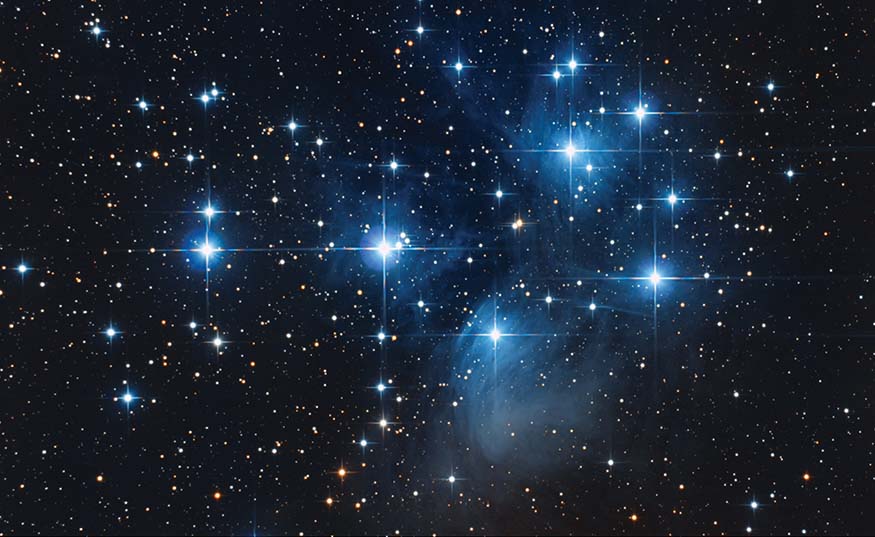
BEAUTY: 
BRAGGING RIGHTS: You saw the famous Seven Sisters
HOW EASY IS IT TO SEE? Best with binoculars or small telescope
BEST TIME TO SEE IT: Winter (in Taurus)
TYPE: Open cluster
DISCOVERED: Known since antiquity
The Pleiades hold a special place in almost every human civilization. To ancient Europeans they were the Seven Sisters; Arab scholars mentioned them in Islamic literature and called them Thurayya; to the Vikings, they were Freyja’s hens; and the Japanese named them Subaru, which means “coming together.”
On a crisp winter night you can look up and see this beautiful cluster, and perhaps wonder what our ancestors thought as they looked at the exact same sight all those years ago.
Today, thousands of years after they were first observed we know that the Pleiades are a cluster of young and bright stars, all born in the same nebula, and they’ve only recently (within the last 20 million years) become hot enough to burn off the remnants of their gaseous cocoon. Powerful telescopes reveal far more than the seven traditional members: at least 1,000 stars are thought to be part of the Pleiades.
Faint galaxies and nebulae look wonderful in photos but inevitably disappoint when viewed directly. But bright clusters like the Pleiades are the opposite: photos can’t capture the twinkling brightness of these jewels against the black depths of space.
WHAT YOU MIGHT SEE THROUGH AMATEUR EQUIPMENT
The Pleiades are beautiful even with the naked eye, but a good pair of binoculars or a rich-field telescope will show you dozens more stars. If you use binoculars, mount them on a steady tripod so you can spend time taking in the entire scene.
If you use a telescope, make sure it has a short focal length and low power so you can fit the entire cluster. A 4" reflecting telescope at 25× power is ideal, but a small refractor would also work. Avoid Cassegrain reflectors (such as Schmidt-Cassegrains or Maksutov-Cassegrains), which are great for planets but magnify too much for the Pleiades. (See for more information.)
How many stars can you see? Without using binoculars or telescopes, look up at the Pleiades like our ancestors did. How many stars can you see? There are at least 10 stars brighter than magnitude 6; some are close together and spotting them is a good way to test your vision.
In the days prior to light pollution, stargazers were able to see 12 or 14 stars. On a dark, moonless night away from light pollution, you might be able to match them. Take your time trying to see them all. It might even help to draw a diagram of the stars you see, to better uncover the ones you’ve missed.
One star or two? With binoculars you’ll see dozens of bright stars shining against a black sky. You might notice that some stars that appeared to be solitary are actually two stars close together. Armed with this knowledge, see if you can spot them as doubles without using binoculars.
Nebulosity. Long-exposure photos show the Pleiades enveloped in a faint blue reflection nebula. Though this was once thought to be part of the cluster’s original birth nebula, astronomers now believe this is an unrelated nebula that the cluster wandered into. The blue light of these brilliant stars lights up the nebula much like the moon when seen through gossamer clouds.
Seeing the nebula through a telescope will be a challenge. Wait for a moonless night and travel to a place with dark skies—the faintest light pollution will overwhelm this delicate nebula.
But with luck, perseverance, and a rich-field, lower-power telescope, you should be able to see some faint nebulosity around the four brightest stars.
TAURUS REGION IN WINTER; 30-DEGREE FIELD OF VIEW